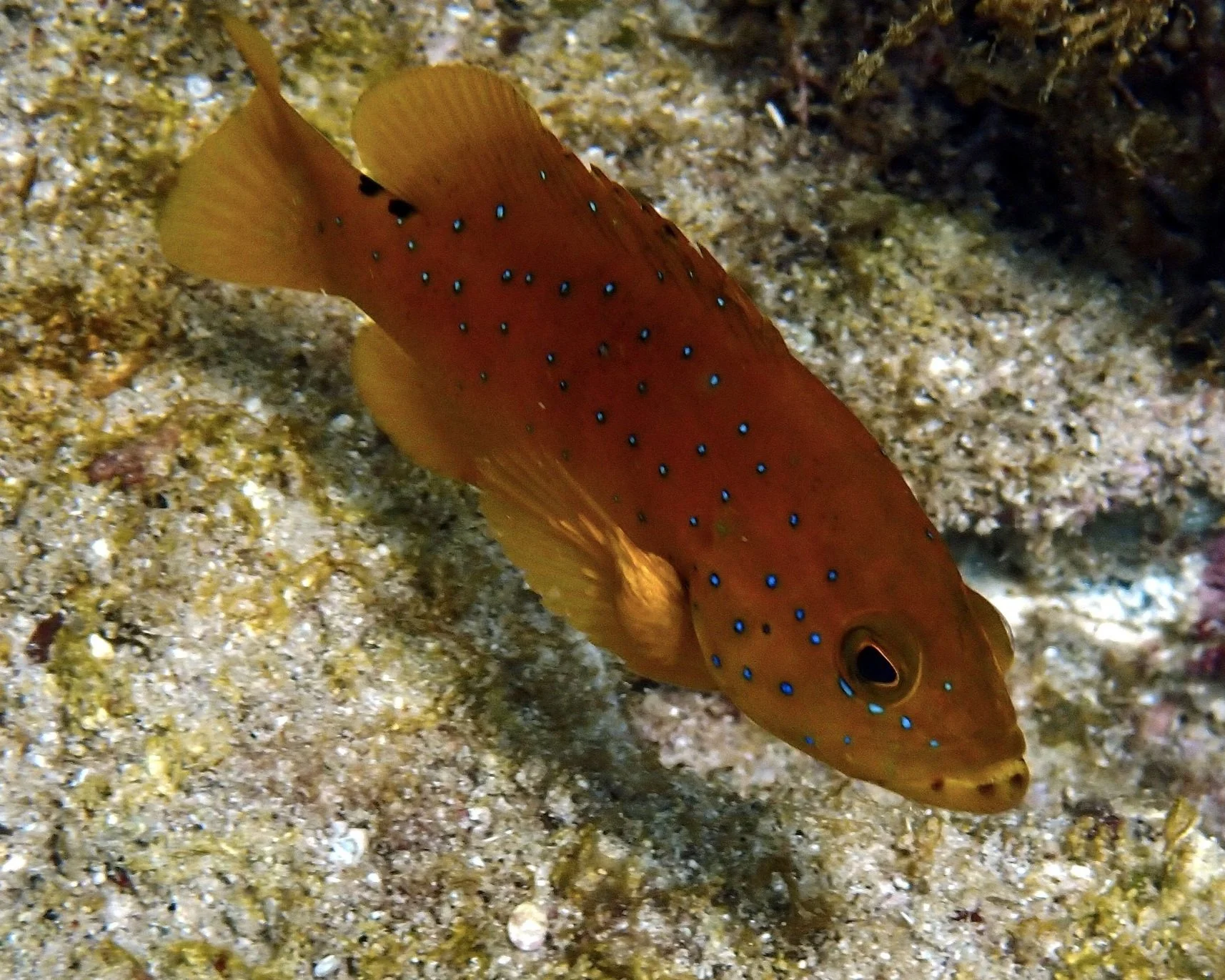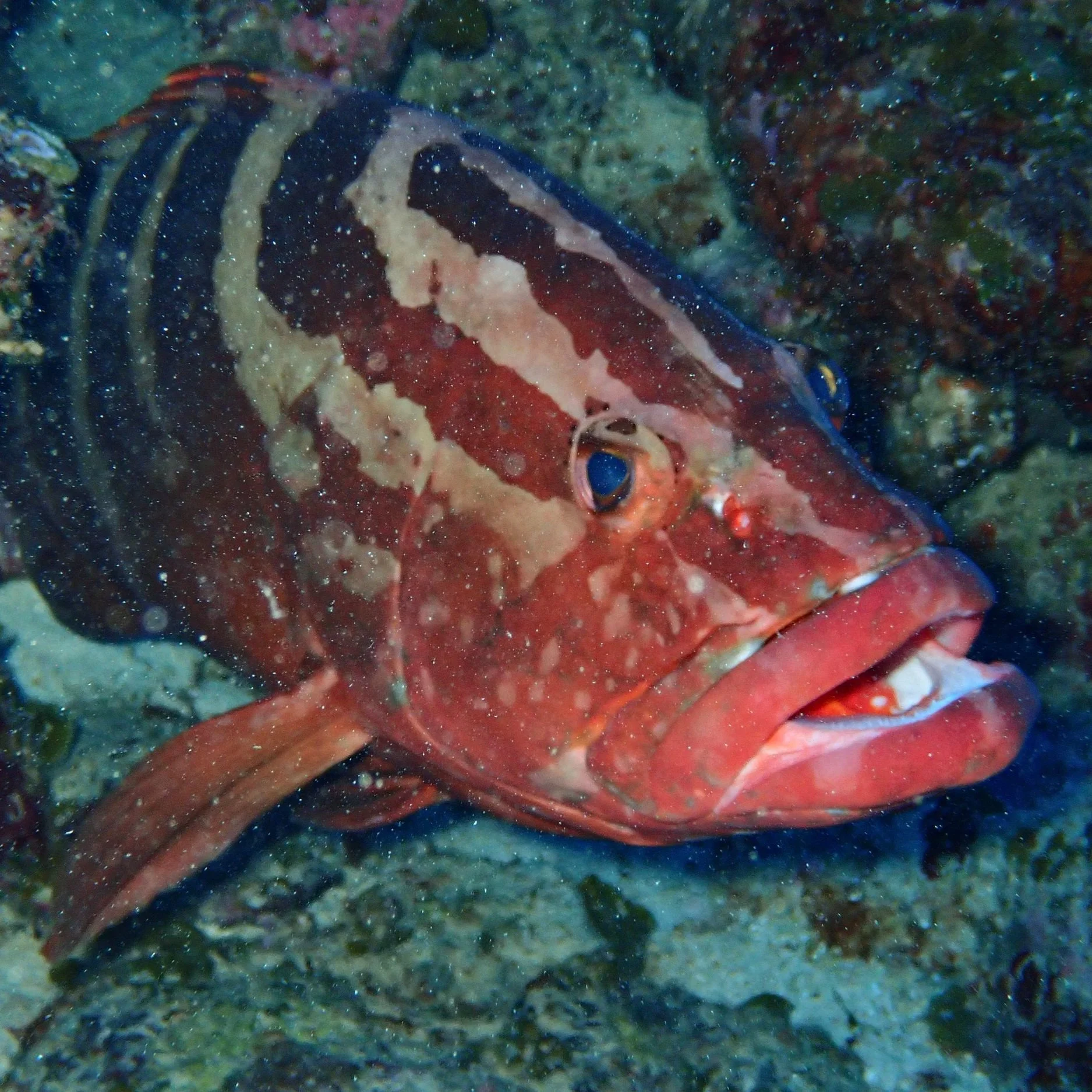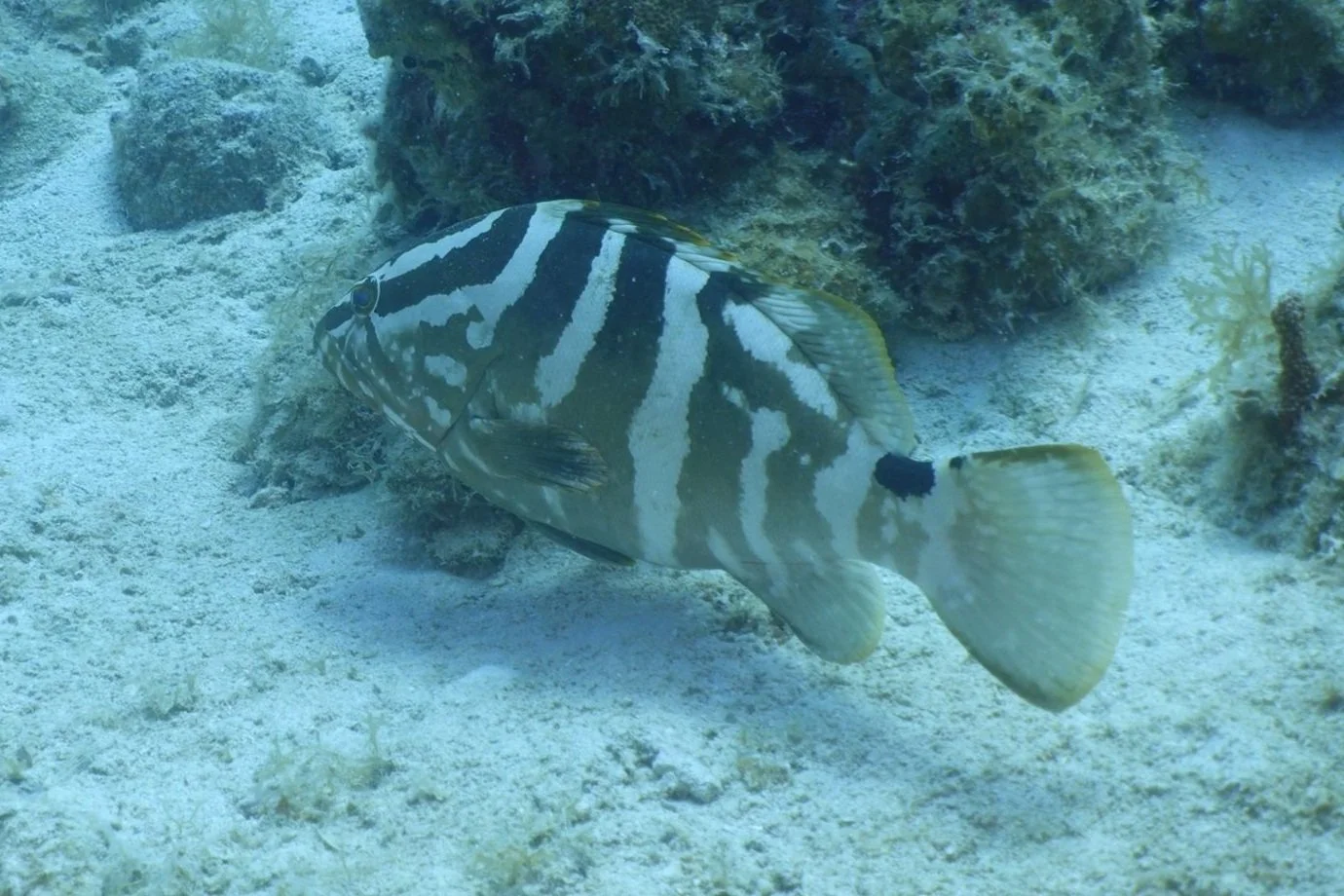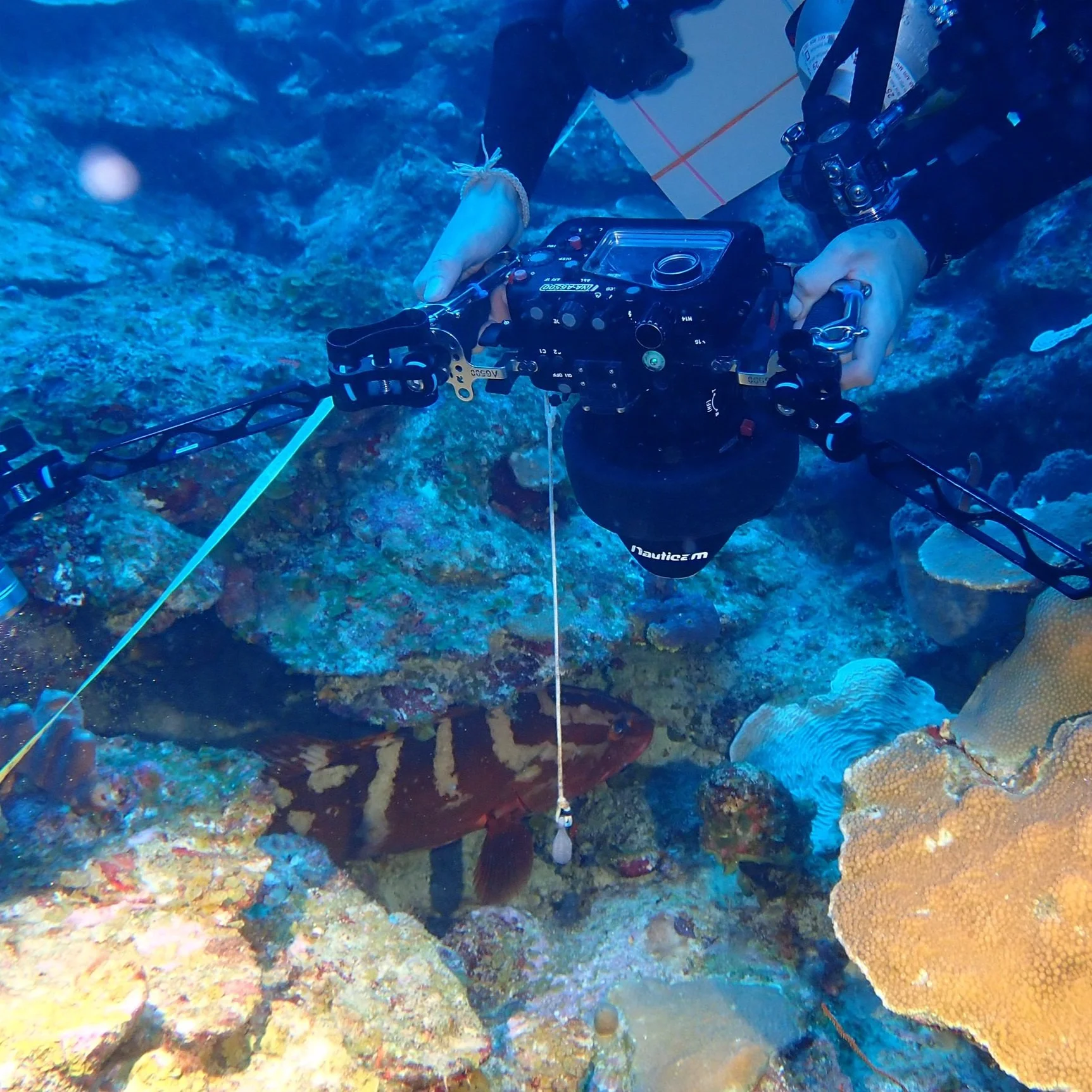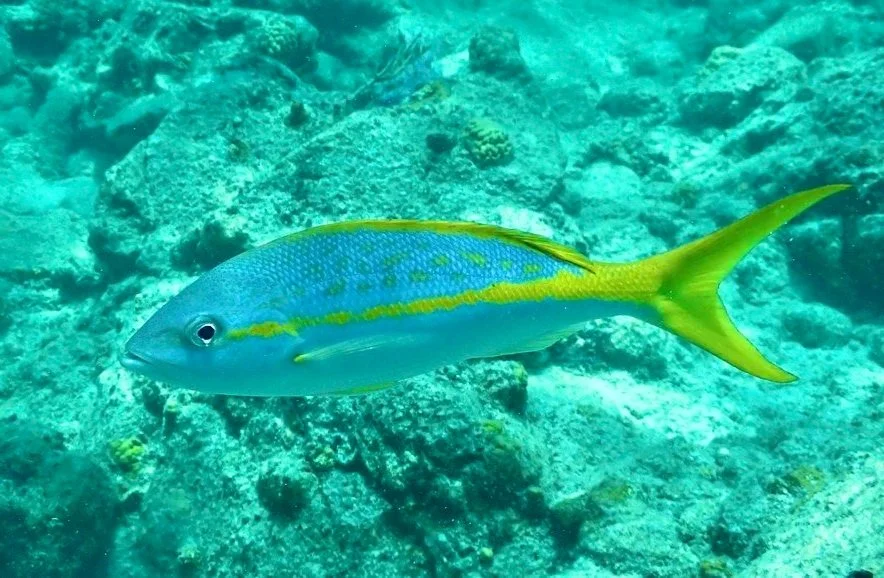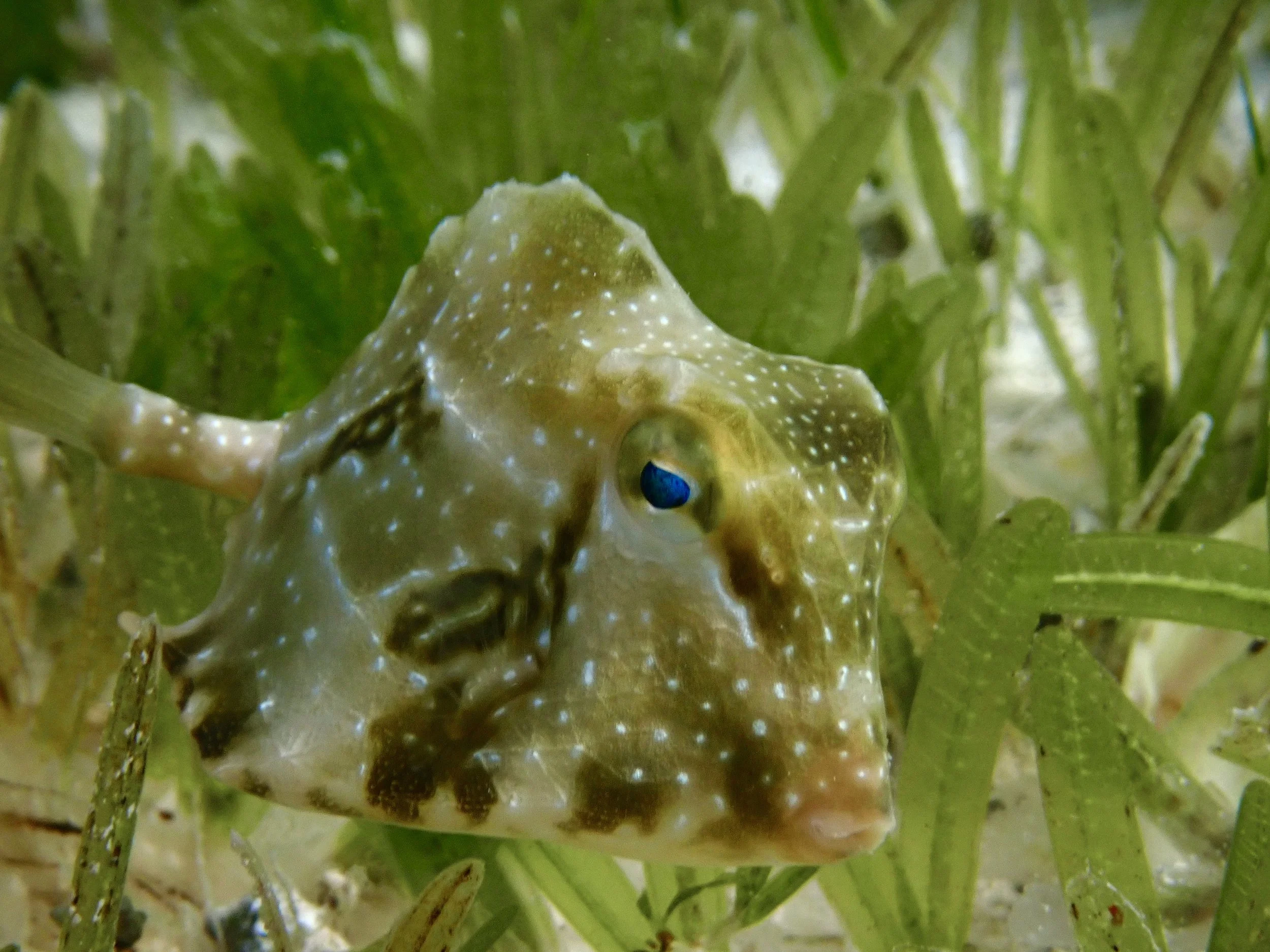Commercially Important Fish
POPULATIONS OF COMMERCIALLY IMPORTANT FISH SPECIES
Photo: Nicole Krampitz
Photo: Kaya Carrion
Photo: Nicole Krampitz
Reef fishes serve important ecological roles that directly and indirectly affect the health of coral reefs. For example, large‐bodied parrotfishes are grazers of macroalgae that displace juvenile corals and compete with adult corals for reef space (Mumby 2006), increasing coral disease and mortality (Smith et al. 2006). In addition, commercially important species are also important predators that create cascading effects with the potential to improve reef health (Sandin et al. 2008). Maintaining healthy populations of reef fishes is a worthy/valuable management target as a way to promote sustainable fisheries resources and overall reef health and function.
In the USVI, assessments of reef fish populations have been few and tended to focus on marine reserve effectiveness. The TCRMP has assessed populations of fishes across many sites (5 – 40m depth). Fish census data between 2003 and 2009 showed that many species that were relatively common on St. John‐St. Thomas reefs were in low abundance on St. Croix reefs (Fig. 4). Fishing pressure as measured by the number of registered commercial fisherman versus shelf area (<65 m depth) was approximately four times greater per area on St. Croix than on St. Thomas‐St. John, largely because the northern USVI has about three times as much deep shelf area (26‐65m depth). Shallow St. Croix waters also allowed more intensive netting & spearing on SCUBA. In addition, many snapper species are avoided south of St. John and St. Thomas due to Ciguatera Fish Poisoning.
These data suggest that some fish species on St. Croix are severely overfished and cannot perform their critical ecological roles as predators and grazers. In territorial and federal waters of the USVI insular shelf, many limited‐ or no‐take marine protected areas and specially protected species regulations (e.g., no possession of Nassau grouper and blue, midnight, and rainbow parrotfish) are only a decade old or less. Therefore, regulations may not have had sufficient time to rebuild fish stocks. Yet, many of these restrictions are not enforced, therefore, the intended impact of protecting and restoring these vital fish populations may not be realized.
RECOMMENDATIONS
STRATEGY 1
Maintain and enforce current fisheries regulations so that the intended benefits of protection can be realized. Examine the marine protected areas network to identify unprotected areas that might be important to rebuilding fisheries stocks or protected areas that are not performing a stock enhancement role. Also, pay attention to ecologically important areas, such as boulder star coral reefs recovering from bleaching mortality, where sustaining high fish abundance is important to enhancing reef recovery.
STRATEGY 2
Identify and protect fish spawning aggregations (FSA). All reproductive fish from an entire population can be concentrated in FSA where they are most vulnerable to overexploitation. Loss of entire local populations is possible if these FSA are allowed to be exploited.
STRATEGY 3
Research the ecological roles of fisheries species, such as parrotfish, to determine populations necessary to maintain reef health and incorporate results into management strategies.
STRATEGY 4
Promote the harvest of the invasive Indo-Pacific lionfish (Pterois volitans), which is a voracious consumer of young and small fishes.
Photo: Sonora Meiling
Photo: Sarah Heidmann
IMPROVED SIGNS FOR THE THREATENED NASSAU GROUPER
Photo: Nicole Krampitz
Photo: Viktor Brandtneris
Photo: Nicole Krampitz
The once prolific Nassau grouper (Epinephelus striatus), is today commercially extinct over much of its range. Historically this species has been dominant both culturally and economically in Caribbean fisheries. Although protected in federal waters of the United States since the 1990’s, the Nassau is still considered to be one of the most threatened groupers worldwide, is listed as endangered on the IUCN Red List, and is a candidate for the US Endangered Species Act. The fish was at one time the most common grouper on reefs of the US Virgin Islands. The Nassau fishery collapsed in the 1980’s, shortly after a large Nassau grouper spawning aggregation site located south of St. Thomas was extirpated by overfishing in the 1980’s and as a possible consequence the fishery collapsed shortly afterwards. The territorial government of the USVI protected the Nassau grouper from all fishing in 2006. The Caribbean Fisheries Management Council closed the south St. Thomas Grammanik Bank yellowfin grouper spawning aggregation site in 2005, inadvertently protecting a small spawning aggregation located on a few kilometers to the west.
There is some evidence that these management measures may be positively affecting Nassau grouper populations in the US Virgin Islands. Over the past two years there have been reports by divers of the fish being seen commonly on reefs around the territory, and fishermen are reporting regular occurrences of Nassau grouper in their fish traps. In TCRMP survey data from 2015 and 2016, substantially more Nassau grouper were observed than in earlier years. The fish was seen on nine sites in the northern USVI during those years. On St. Croix, five Nassau grouper were recorded on transects in 2015-16. Additionally, juvenille young-of-the-year Nassau were commonly seen in nearshore areas of St. Thomas and St. John in 2006, 2014, 2015, and 2016 (R. Nemeth, unpub data).
Nassau grouper in the northern USVI may be recovering in part because of a growing spawning aggregation at the Grammanik Bank. The Grammanik Bank, located approximately 4 km east of the historic Nassau grouper spawning site, is a multi-species aggregation area hosting spawning of several species of fish including yellowfin grouper (Mycteroperca venenosa), tiger grouper (Mycteroperca tigris), dog snapper (Lutjanus jocu), cubera snapper (Lutjanus cyanopterus), and Bermuda chub (Kyphosis sectatrix). Nassau grouper also aggregate on the site and spawn there shortly after dark in the months of January through April. The bank is closed seasonally to fishing from February 1 to April 31 and is closed to bottom tending gear year-round, thus providing partial protection for the aggregating Nassau grouper. Nassau may have shifted to spawning at the Grammanik bank after fishing down of their nearby historic aggregation. The Nassau grouper spawning aggregation site at the Grammanik Bank is of disputed age, and some local fishermen claim that the bank is not a historical location for Nassau spawning, whereas others suggest that a small number of Nassau have always spawned in that location (anon). The historic Nassau grouper aggregation sites is 4 km to the west, but no fish have been observed to aggregate in this area after over a decade of observation (R. Nemeth, unpub. obs.). One hypothesis is that the Nassau grouper now utilizing the Grammanik Bank are a small sub-population of that original spawning group from the historic bank.
The Nassau grouper has increased in numbers on the Grammanik Bank during the week after the full moon of January through April since 2002. In both January and February 2017, nearly 200 fish were observed on single dives on the western end of the bank. This represents over a 200% increase from the number of fish observed during the early and mid-2000’s.
The early and tentative recovery of the Nassau grouper in the northern USVI is indeed positive, but is far from complete. While fisheries closures have helped, targeted conservation actions may also be important for locking in and building on these gains for this threatened fish. Nassau grouper caught incidentally from deeper water (>20m deep) usually need to have their swim bladders deflated to allow them to submerge and survive when released. Thus, avoiding incidental capture even with release is important. In the northern USVI, a more complete fishing closure of the Grammanik Bank that encompasses the full seasonal cycle of Nassau grouper spawning activities (December to May) would ensure minimal incidental capture. Additionally, creating a migratory corridor between the nearby Hind Bank Marine Conservation District, a no-take closure that appears to support a relative high adult population on Nassau, would also limit fisheries impacts. In St. Croix, where a struggling small population of Nassau grouper are present, closing an area at the tip of the Lang Bank where there is a small aggregation of about 10 individuals would help to ensure that they are not taken incidentally or poached. In all of the USVI more education on Nassau grouper and their protected status would be very helpful. The early life cycle of Nassau grouper typically involves settling in shallow, nearshore structures surrounded by seagrass. These juveniles are vulnerable to recreation line fishing and spearfishing before they migrate to more offshore locations. Education and citizen science to get the community behind the recovery of Nassau would greatly enhance the protections already in place by encouraging compliance. Nowhere else in US waters is the chance to protect and recover the Nassau as strong as in the USVI and the territory could lead a huge conservation success story for ailing fish populations.
Photo: Andrew McGregor
Photo: Nicole Krampitz
